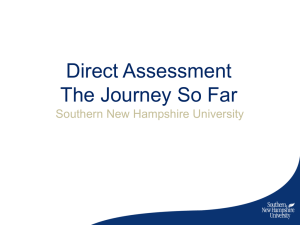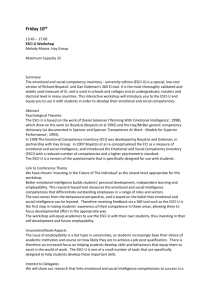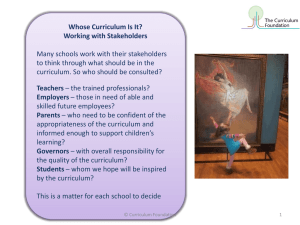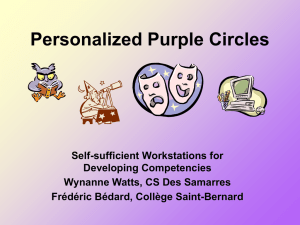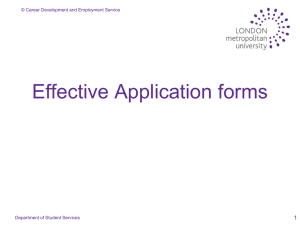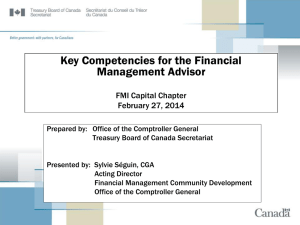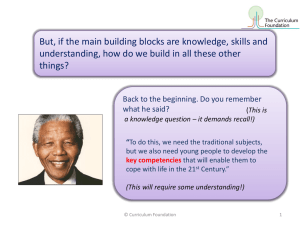Lecturer Competencies: a new framework
advertisement
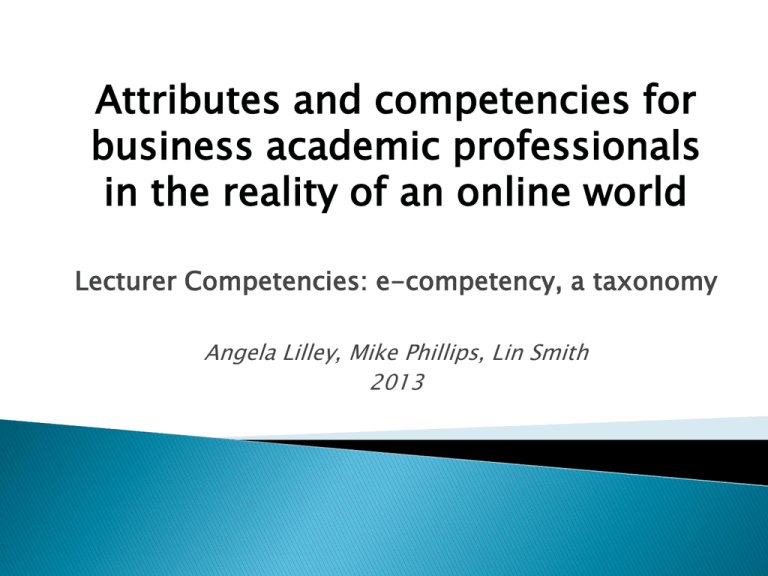
Attributes and competencies for business academic professionals in the reality of an online world Lecturer Competencies: e-competency, a taxonomy Angela Lilley, Mike Phillips, Lin Smith 2013 Introduction – key issues and rationale Facilitated discussion A: review, additional e-competencies; consider ‘meta’ competencies Facilitated discussion B: develop personal/team development action plan Summary and networking opportunities What should be the e-competencies of an online lecturer? How much do lecturers need to understand the pedagogy of e-learning, adult learning, learning design? How far does the academic lecturer need to become a learning designer? How much do lecturers need to know about technology enhanced learning and Web 2.0 approaches? QAA Part B Assuring and enhancing academic quality 3: Learning and Teaching/P14 Higher education providers determine what is necessary to demonstrate that a member of staff is qualified to fulfil their role in teaching or supporting learning; whether this means the individual holds a relevant formal qualification will depend on the circumstances. Staff recruitment and appointment procedures include a means of ensuring new staff have an appropriate level of competence for the teaching and/or learning support role to which they are being appointed. In particular the provider considers the extent to which members of staff have: • appropriate and current practitioner knowledge and an understanding of the subject they teach (which may be demonstrated by a qualification) and an understanding of the disciplinary scholarship appropriate to the academic level of the students they are teaching • the necessary skills and experience to facilitate learning in the students they are interacting with, and to use approaches grounded in sound learning and teaching scholarship and practice. (2012) UK Quality Code for Higher Education People and culture initiative Leadership competency framework Drivers: student satisfaction; retention and progression; Key Information Sets (KIS) Tuition strategy: Supported Open Learning AL Recruitment and practitioner context New AL contract AL Career Development Staff Appraisal (CDSA) Staff Development: Induction, ICT training, CPD, Professional Development Framework HEA accreditation Beyond Induction, Probation, Promotion Identify core and desirable competencies for online tutor role Identify strengths and weaknesses Identify affinities and gaps in Knowledge, Skills and Attributes Create pathways for development/talent management Support academic aspirations: research and scholarship interests Underpin consistency of delivery MOOCs are offering the chance to learn how people learn online in groups, massive or not (JISC cetis white paper) http://publications.cetis.ac.uk/2013/667 Learning from MOOCs informs e-competencies. EdX is using these to learn how to support their on campus students HEA has professional standards and now JISC has begun to consider how online learning changes these https://ukpsfguide.pbworks.com/w/page/62948690/Home Boyatzis (1982): ‘an underlying characteristic of a person’; a ‘motive, trait, skill, aspect of one’s self image or social role or a body of knowledge which he or she uses’. ‘Competencies deal with the behaviours people need to display …to do the job effectively…and not with the job itself’ Different frameworks: i) Universal – top management or generic ii) Supra competencies, Intellectual, Interpersonal, Adaptability, Results orientation. iii) Behavioural, Functional, Technical Woodruffe (1993) Individual measurable skills to do a job in a range of contexts (Stevenson, Weil 1998, and Staron 2008) Capabilities are the confidence to apply Competencies Our set of draft competencies allow self assessment against competence to do something Try them, let’s see how they may be measurable Look at the framework and work together on the following questions. Appoint a lead for the plenary discussion. Does this list address the demands of the online world? Is the grouping appropriate? Other groupings? What do you think of this approach? Could it work for you? Discussion in Plenary Now complete the framework for yourself or a colleague. 1. Are there any other e-competencies you would add here? 2. How could you use the framework? 3. What do you think of this approach to a needs analysis to inform staff development and talent management in Business Education? What should be the e-competencies of an online lecturer? How much do lecturers need to understand the pedagogy of e-learning, adult learning, learning design? How far does the academic lecturer need to become a learning designer? How much do lecturers need to know about technology enhanced learning and Web 2.0 approaches? Measurement of competency - self assessment is not enough How do we measure e-competencies so we can have effective measurement of performance and develop key performance indicators? Sharing collective learning? Join a special interest group……email list Contact details: l.f.smith@open.ac.uk m.r.phillips@open.ac.uk angela.lilley@open.ac.uk Barney and Hesterley (2010), Strategic Management and Competitive Advantage: concepts Boyatzis, R. (1992), The Competent Manager, Wiley, New York, NY Prahalad & Hamel (1990), The Core Competence of the Corporation Woodruffe, C (1993) Leadership and Organisation Journal, Vol. 14 No 1, pp.29-36 MCB University Press 0143-7739 CIPD (2012), Fact Sheet on Competencies Williams, P. (2003). Roles and Competencies for Distance Education Programs in HE LSC (2007), A professional development framework for elearning Staron (2008) - Workforce Development - a whole-of-system model for workforce development http://lrrpublic.cli.det.nsw.edu.au/lrrSecure/Sites/Web/13289/ezine/year_2008/sep/thinkpiece _whole_system_approach.htm




